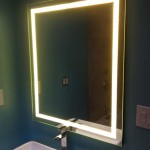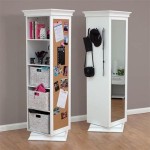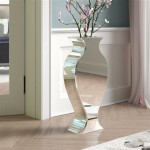How to Hang a Heavy Mirror Without a Stud
Hanging a heavy mirror can significantly enhance the aesthetic appeal of a room, adding light and creating a sense of spaciousness. However, finding a wall stud in the desired location is not always possible. This presents a challenge, as directly attaching a heavy mirror to drywall without sufficient support can lead to the mirror falling and potentially causing damage or injury. Therefore, understanding alternative methods for securely hanging a heavy mirror when studs are unavailable is crucial.
This article will explore several techniques that provide adequate support for heavy mirrors, even when a direct connection to a stud is not feasible. These methods rely on specialized hardware and strategic weight distribution to ensure the mirror remains safely and securely mounted to the wall. A thorough understanding of these techniques ensures a safe and aesthetically pleasing outcome.
Understanding Weight Limits and Wall Types
Before attempting to hang a heavy mirror, it is essential to understand the weight limits of different wall types and hardware. Drywall, the most common wall material, has a limited weight-bearing capacity. Its strength varies depending on its thickness (typically ½ inch or 5/8 inch) and its composition. Lighter mirrors, weighing up to around 10-15 pounds, can often be supported by standard drywall anchors. However, heavier mirrors require more robust solutions.
Plaster walls, though less common in modern construction, can be more durable than drywall. However, they can also be more brittle and prone to cracking. Special care must be taken when using anchors in plaster to avoid damaging the surrounding material. Brick or concrete walls offer the greatest weight-bearing capacity, but require specialized drilling and anchoring techniques.
The weight of the mirror is a critical factor in determining the appropriate hanging method. Always weigh the mirror before purchasing any hardware. It is also important to consider any additional weight the mirror might bear, such as from decorative frames or added embellishments. Exceeding the weight limit of the chosen hardware can lead to failure and potential damage.
Utilizing Heavy-Duty Drywall Anchors
For mirrors weighing between 15 and 50 pounds, heavy-duty drywall anchors can provide a reliable solution. These anchors are designed to distribute weight over a larger area of the drywall, increasing their weight-bearing capacity compared to standard anchors. There are several types of heavy-duty drywall anchors available, each with its own installation process and weight rating.
Toggle bolts are a popular choice for hanging heavy objects on drywall. They consist of a bolt and a wing-like toggle that folds flat to pass through a hole in the wall. Once inside the wall cavity, the toggle springs open, providing a wide bearing surface against the back of the drywall. This distributes the weight more effectively, allowing toggle bolts to support significant loads. To install toggle bolts, a hole slightly larger than the bolt diameter is required. Ensure the selected toggle bolt has a weight rating that exceeds the weight of the mirror plus a safety margin.
Molly bolts are another type of heavy-duty anchor that can be used for hanging mirrors. These anchors work by expanding behind the drywall as the bolt is tightened. The expansion creates a strong, secure hold. To install molly bolts, drill a hole the appropriate size for the anchor and insert the bolt. As the bolt is tightened, the anchor expands and grips the drywall. Molly bolts are generally easier to install than toggle bolts, but they may not provide the same level of weight capacity.
Self-drilling drywall anchors, sometimes called self-tapping anchors, are designed to be installed directly into drywall without pre-drilling a hole. These anchors have a sharp point that allows them to be screwed directly into the wall. While they are easier to install than other types of anchors, their weight-bearing capacity is typically lower. They are best suited for lighter mirrors or for situations where multiple anchors can be used to distribute the weight.
When installing any type of drywall anchor, carefully follow the manufacturer's instructions. Over-tightening the anchor can damage the drywall and reduce its holding power. It is also important to ensure that the anchor is properly seated in the wall before hanging the mirror. If the anchor feels loose or unstable, it should be removed and replaced with a new one.
Employing French Cleats
French cleats offer a versatile and secure method for hanging heavy mirrors without relying on studs. A French cleat consists of two interlocking pieces of wood or metal that are angled at 45 degrees. One piece is attached to the wall, and the other is attached to the back of the mirror. The mirror is then hung by sliding the angled piece on the mirror onto the angled piece on the wall.
French cleats distribute the weight of the mirror along the entire length of the cleat, rather than concentrating it at a single point. This makes them ideal for hanging large, heavy mirrors. The horizontal distribution of weight also means that even if one section of the cleat fails, the rest of the cleat will continue to support the mirror. This provides an added level of safety and security.
To install a French cleat, start by attaching one of the cleat pieces to the back of the mirror. Use screws that are long enough to penetrate the mirror frame securely, but not so long that they protrude through the front. Ensure that the cleat is level and securely attached to the mirror. Accurately measuring to secure the mirror cleat is important for a level final placement.
Next, attach the other cleat piece to the wall. Use a level to ensure that the cleat is mounted straight. For heavier mirrors, it may be necessary to use drywall anchors to provide additional support for the wall cleat. When choosing anchors, select ones with a weight rating that exceeds the weight of the mirror plus the weight of the cleat itself. Proper wall cleat installation is critical to the success of this method.
Once both cleat pieces are securely attached, carefully lift the mirror and slide the angled piece on the mirror onto the angled piece on the wall. The mirror should hang securely and level. If the mirror is not level, shims can be used behind the wall cleat to make minor adjustments. Consider the weight distribution across the cleat when placing the mirror.
Creating a Support Structure
In situations where the mirror is exceptionally heavy, or where the wall is particularly weak, it may be necessary to create a support structure to distribute the weight more effectively. This can involve adding a backer board to the wall or building a custom frame to support the mirror.
A backer board is a piece of plywood or other sturdy material that is attached to the wall behind the mirror. The mirror is then attached to the backer board, which distributes the weight over a larger area of the wall. This can significantly increase the weight-bearing capacity of the wall.
To install a backer board, measure the area of the wall where the mirror will be hung. Cut a piece of plywood or other sturdy material to the appropriate size. Attach the backer board to the wall using screws that are long enough to penetrate the studs, if possible. If studs are not available, use heavy-duty drywall anchors to secure the backer board to the wall. Ensure that the backer board is level and securely attached to the wall. The backer board must be flush to the wall surface.
Once the backer board is installed, the mirror can be attached to the backer board using screws or other fasteners. Choose fasteners that are appropriate for the weight of the mirror and the thickness of the backer board. Ensure that the fasteners are securely tightened, but not so tight that they damage the backer board or the mirror frame. Align the mirror properly on the backer board before securing.
Another option is to build a custom frame to support the mirror. This frame can be constructed from wood or metal and designed to distribute the weight of the mirror evenly across the wall. The frame can be attached to the wall using screws or other fasteners, and the mirror can then be mounted within the frame. A custom frame can also offer additional aesthetic design elements.
When designing a support structure, it is important to consider the overall appearance of the mirror and the surrounding room. The support structure should be designed to be as unobtrusive as possible, while still providing adequate support for the mirror. Consider painting or finishing the support structure to match the wall or the mirror frame. The support structure should be structurally sound and securely mounted.
How To Hang A Heavy Mirror On Drywall Without Damaging It Or The Wall Quora

How To Hanging A Mirror Without Stud Heavy

How To Hang A 31kg Mirror On Wall With Bunnings Work Community

How To Hang Heavy Items Without A Stud

A Better Way To Hang Heavy Mirror Hanging Picture Wire

How To Hang A Heavy Mirror Or Picture On Wall Today S Homeowner

Tip How To Hang Something Heavy With Minimal Wall Damage Home Stories A Z

How To Hang A Large Or Heavy Mirror

How To Hang A Heavy Mirror C R F T

How To Hang A Heavy Mirror Or Picture She Holds Dearly








